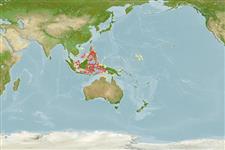>
Blenniiformes (Blennies) >
Tripterygiidae (Triplefin blennies) > Tripterygiinae
Etymology: Helcogramma: Greek, helkos, -eos, -ous = ulcer, sore + Greek, gramma = letter, mark (Ref. 45335); albimacula: The species epithet is a combination of the Latin "albus", meaning white, and "macula", meaning spot. The name refers to the pale spot on the ventral part of the pectoral fin base of preserved specimens and is treated as Noun in apposition..
Environment: milieu / climate zone / depth range / distribution range
Ökologie
seewasser benthopelagisch; tiefenbereich 0 - 5 m (Ref. 52308). Tropical
Western Pacific.
Size / Gewicht / Alter
Maturity: Lm ? range ? - ? cm
Max length : 4.2 cm TL Männchen/unbestimmt; (Ref. 90102)
Kurzbeschreibung
Morphologie | Morphometrie
Rückenflossenstacheln (insgesamt): 16 - 18; Rückenflossenweichstrahlen (insgesamt): 112; Afterflossenstacheln 1; Afterflossenweichstrahlen: 20 - 22; Wirbelzahl: 37. A species of Helcogramma (sensu Hansen, 1986) with 2 symphysial mandibular sensory pores, second dorsal fin spines usually XIV (two of 80 specimens with XIII and 11 with XV), third dorsal fin segmented rays 10-11, last ribs on vertebral centrum 10, vertebrae modally 10+27=37, pored lateral line scales modally 19 or 20, nape scales present, males with dusky anal fin, both sexes with distinctive pale (red in life), oblong streak over lowest pectoral fin ray bases, adult males first dorsal elongate, reaching base of fourth to sixth spine of second dorsal fin when depressed (Ref. 52308).
Adults are found at depths of 5 m and shallower, in surge channels and exposed boulders (Ref. 90102). Eggs are hemispherical and covered with numerous sticky threads that anchor them in the algae on the nesting sites (Ref. 240). Larvae are planktonic which occur primarily in shallow, nearshore waters (Ref. 94114). Minimum depth from Ref. 58018.
Life cycle and mating behavior
Geschlechtsreife | Fortpflanzung | Ablaichen | Eier | Fecundity | Larven
Williams, J.T. and J.C. Howe, 2003. Seven new species of the triplefin fish genus Helcogramma (Tripterygiidae) from the Indo-Pacific. aqua, J. Ichthyol. Aquat. Biol. 7(4):151-176. (Ref. 52308)
IUCN Rote Liste Status (Ref. 130435)
Bedrohung für Menschen
Harmless
Nutzung durch Menschen
Mehr Information
NamenSynonymeMetabolismusRäuberÖkotoxikologieFortpflanzungGeschlechtsreifeAblaichenSpawning aggregationFecundityEierEientwicklung
ReferenzenAquakulturAquakultur ProfilZuchtlinienGenetikElectrophoresesVererbbarkeitKrankheitenVerarbeitungNutrientsMass conversion
PartnerBilderStamps, Coins Misc.LauteCiguateraGeschwindigkeitSchwimmstilKiemenoberflächeOtolithsGehirngrößeSehfähigkeit
Tools
Zusatzinformationen
Download XML
Internet Quellen
Estimates based on models
Preferred temperature (Ref.
123201): 28 - 29.3, mean 28.8 °C (based on 659 cells).
Phylogenetic diversity index (Ref.
82804): PD
50 = 0.5000 [Uniqueness, from 0.5 = low to 2.0 = high].
Bayesian length-weight: a=0.00562 (0.00258 - 0.01228), b=3.08 (2.89 - 3.27), in cm total length, based on LWR estimates for this (Sub)family-body shape (Ref.
93245).
Trophic level (Ref.
69278): 3.0 ±0.3 se; based on size and trophs of closest relatives
Widerstandsfähigkeit (Ref.
120179): hoch, Verdopplung der Population dauert weniger als 15 Monate. (Preliminary K or Fecundity.).
Fishing Vulnerability (Ref.
59153): Low vulnerability (10 of 100).
Nutrients (Ref.
124155): Calcium = 1040 [381, 4,376] mg/100g; Iron = 3.87 [1.37, 9.59] mg/100g; Protein = 16.7 [15.0, 18.5] %; Omega3 = 0.131 [0.028, 0.663] g/100g; Selenium = 82.7 [14.6, 419.3] μg/100g; VitaminA = 24.4 [3.2, 187.4] μg/100g; Zinc = 5.78 [2.59, 10.97] mg/100g (wet weight);
